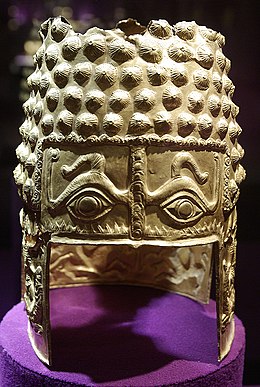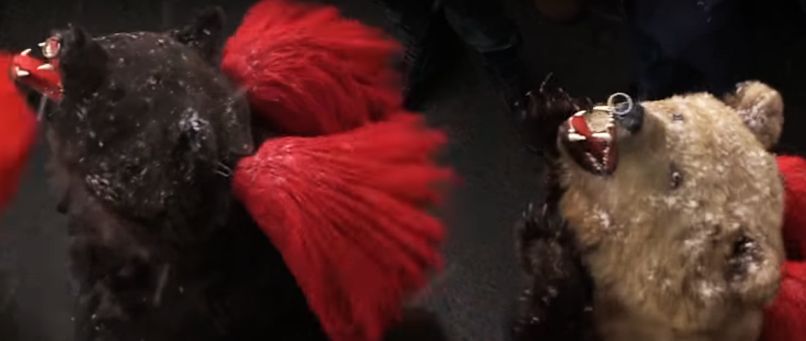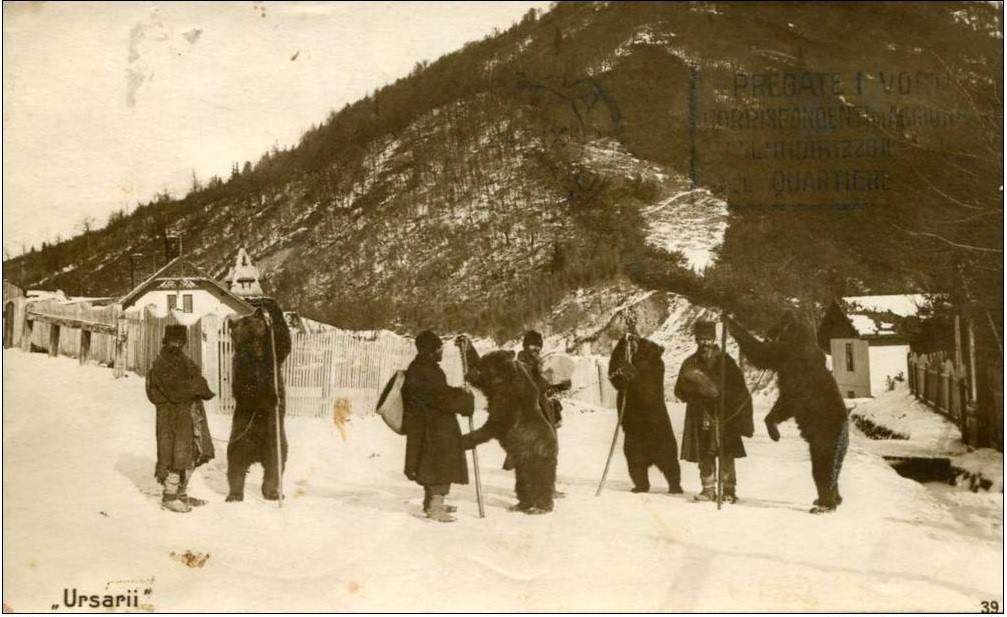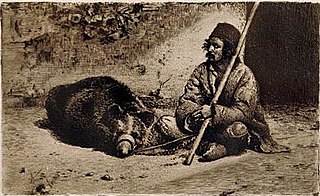The good, old bear, or the grizzly ursine, populated Romanian mythology since the times of the Thracians, and tales of its powers and wisdom have left their paw-prints on the Romanian folklore too.
The bear as a totem, as a symbol of one’s ancestry, was an animal revered by ancient Thracian religion, alongside the wolf. Why, it is even whispered in legends that the great Zalmoxix, the god worshiped by Geto-Dacians, was wrapped in a bear’s skin right after his birth. To soak up the power and the strength of the great beast, and perhaps even its endurance.
It isn’t a coincidence then that the bear held an important place in the beliefs and conscience of peoples all over the world. In the Celtic world, the bear was the symbol of warriors and even the root of its Celtic name, artos, sends us to the myth of the bear-goddess Artio and even tothe legend of King Arthur.
In the folklore of Siberia and Alaska, the bear is the beastly equivalent of the Moon as it disappears in late autumn only to reappear in spring. Here, plenty are those who consider the bear as man’s ancestor.
The Bear in Romanian Mythology

In Romanian mythology the bear is invested with apotropaic powers, able to avert evil influences or to turn around bad luck. While his presence, his spirit, also hold therapeutic and meteorological virtues.
The Golden Helmet of Cotofenesti, Geto-Dacian, 4th cent.BC @ National History Museum Bucharest
— Pat Furstenberg, Author✒🏰 #Im4Ro 🔛 bit.ly/Im4Ro (@PatFurstenberg) February 18, 2022
AND
(exciting to recognize) a replica worn by late💕Amza Pellea as Decebalus (King of Dacia 87-106AD) in The Dacians movie.#FindsFriday #Im4Ro #Dacia #Roman #Romania #history pic.twitter.com/NTl0k24N37
As a result, the Bear Dance emerged. The choreography, as well as the symbology of the bear mask used, of the strength it inspires, depict both death and resurrection, nature’s natural cycle that no one can escape from. After all, the bear always defeats winter – this cruel mistress that leaves little but ice and snow along her path – and announces the forthcoming spring.
The Bear Dance represents the reminiscent of a pagan ritual and one can still observe it today in villages from Moldavian and Bucovina, in north-east of Romania.
Thus, on New Year’s Eve a sleuth of bears can be observed parading and dancing along the main road. Accompanied by drummers, pan flutes musicians, and whistles blowers, under the command of a bear tamer, the Bear Dance is supposed to bring a fertile New Year to the crowds of cheerful onlookers.

Much like the old year will soon fade, taking its ailments with it, during their dance the bears die and come back to life. Like the New Year will, stronger and happier.
Folk belief goes that the life cycle of the bear is responsible for regulating nature’s seasons. Not a coincidence then that the movement of the Ursa Major constellation is also closely connected to the sequence of the seasons.


During the 18th and the 19th century bear tamers were often seen along the roads of many European mountain villages. Apart from bringing good luck and spreading strength by their sheer presence, bears were, sadly, taught many tricks too.
The bears, accompanied by drummers, danced thus imitating their life in nature. During the ritualistic dance they died and returned to life, symbolizing the renewal of nature at Winter Solstice and the arrival of spring and its win over winter and darkness.
Later, the Bear Dance involved men covered in bear costumes made from straws or sheep leather, covered with sheep fur. In the end of the dance the straw costumes were thrown in fire, symbolizing purification and renewal. Real bear skin was not used as the animal was respected and venerated. Only recently the dancers use real bear costumes.
Luckily, no more life bears on a chain roam the country paths today.
The Bear in Romanian Folklore
In folk tales and legends the bear is indeed depicted as a peculiar creature. But how could they not? Bearing their cubs in the middle of winter; choosing to return to their burrows if the weather turns sunny; choosing forest paths over hibernation if glacial weather advances… Yet there is more. Bears would easily destroy a man-made bridge, yet knock over a tree if a river stops them in their pursuit of food.
Thus, Romanian folklore has associated the bear’s unpredictable behavior with the capricious weather looming between the end of winter and the beginning of spring.
Bear tales…
Bears were believed to heal, through their presence or touch, ailments such as arthritis, rheumatism, or fevers. For example in the area near Suceava, Moldavia, they say that if you allow a bear to step on the small of your back (and survive), you will be saved from any other diseases.
Bears could even heal the evil touch of Ielele, the evil eye, or bad spells. But a bear’s robust step was also meant to bring fertility and good fortune to a young family. Of course, once a bear stepped in one’s farmyard, no evil spirit or wild beast will ever set foot in it again. Makes sense…

I can see now why the bear tamer was always welcomed in people’s yards, and in their homes. To have the bear dance on your property was considered auspicious, and many cheerful days were lined up ahead for your kin.
So, dreamed of a bear lately? Know that you’re in good luck!
Thus, there are a few important dates in Romanian folklore when the Bear, Moş Martin, is celebrated. Here are a few of them.

The Winter Martinii, or San-Martini
Celebrated 40 days after Christmas, between the 1st and the 3rd of February, this celebration is meant to protect livestock and humans against any wolf or bear attacks.
The Bear’s Day, Stretenia (Feats of Presentation), or the telling of a coming spring
Bear’s Day (Ziua Ursului) is celebrated on 2nd February, coinciding with the Christian celebration of the Feast of Presentation, or Stretenia.
The ancestral origin of Stretenia
Stretenia is a celebration as old as the seasons. For it is now when winter and spring stare each other in the eyes. They finally meet again: from the old Slavic word for meeting, greeting, vstrecea –> vstrecenie –> stratenie.
Yet there is another layer to it.
During roman times it was now, in February, that one would prepare oneself, purify oneself to welcome the New Year, celebrated on the 1st of March. Ahead of new field labors meant to start soon, the purification was made with water and fire. Today, candles are used during the Feast of Presentation.
Stretenia, telling the weather
If the bear comes out of his hibernation on this day it means that spring is on its way – even if it’s cold and foggy, even if it snows. The summer will plentiful, the harvest enough for all. But if the bear spots its own shadow on the snow, he will return to its lair for an extra long nap. About 40 days long. Thus, spring is still a long way away.
It clear now why the winter celebrations are connected to the bear ending its hibernation; by following the bear’s behavior, farmers knew when the warm season was approaching.
Interesting to note is that a good wine is said to have bear’s power, while in Romanian folk tradition on the 1st of February Saint Trifon is observed, the protector of vineyards and orchards.
The Bear’s Saturday (Sâmbăta Ursului) – during Easter fasting
Women, especially, celebrated Bear’s Saturday to protect themselves against any beats when rummaging for berries, in summer. So during Bear’s Saturday no one would even whisper the beast’s name. People would not do any work either, so that their cattle and children stay protected against the brown bear.
This Saturday was also considered best for collecting medicinal and magic herbs. for only if picked today do they keep their powers. Like this: when the healing plant was found, a cross was made over it, and a prayer was told. The root was dug out, and in its place a crumb of bread was placed, wetted with a few drops of red wine.

Celebrating the bear in summer
The summer bear’s celebration is connected to honey/ fruit harvest and the peak of the bear mating season – a time when bears move around more than usual and they may accidentally come across humans. Which is why on these days of celebration no work should be performed. On August 13, a special celebration is held, honey pies and wine sweetened with honey are consumed, in the belief that it will protect both livestock and farmers against bear attacks during the honey and fruit and berry harvest (since honey and fruits are part of the bear’s diet). A blessed time, summer preparing for winter by reaping autumn’s bounty.
Romania still holds the largest and most spectacular wilderness of Europe. Its vast ancient forests still grow atop great mountains that reach up and kiss the sky (the Carpathians are 1600 km long, 2544 meters in height). Its winding waters twist and turn among lush flower beds (a third of Europe’s bouquet), and beasts from myth and legend, like the old bear, still roam free.
I’m asking you then, who is the king of animals in Europe?
As always, you can discover my books on Amazon.

left their paw-prints… love the image. Bravo! And I like that you see the humor in the many benefits of encountering a bear. ”Bears were believed to heal, through their touch, ailments such as arthritis, rheumatism, or fevers…” and basically every other ailment… forever! 🙂
Glad you liked that part,Jo 🙂 Ha ha 😉
In the spirit of my mighty ancestors, I must admit that bear is one of my fave. animals. Good for me! 🙂 Furthermore, I observe Bear’s Day. My grandma taught me that if February 2nd is sunny, the bear goes back in his den and the winter lingers. On the contrary, if it’s a cloudy day, then the bear leaves its den and spring will follow shortly. And that proves right every time. So at your final question:
who is the king of animals in Europe?(I think you have a typo there), I answer: The Bear! ❤️Such a wise woman, you Granny. Taught you very well. We let go of such knowledge too easily.
🙂
I’m really keen on folklore. You have no idea how much I enjoyed your post. ❤️ Thank you!
Thank you, Jo!
Interesting.
Glad it stirred your interest, Martie 🙂
I never thought of the bear as anything special, but you have changed my mind! I liked seeing the Celtic and King Arthur connections…
There is so much one one can say about the old bear. It left quite a print, wherever he strolled. And man, always showing himself as the better beast.
Oh, I had to include those connections. Etymology is like tiny molecules of oxygen, one can’t go around it 😉
I wonder how we went from having a bear predict when winter would end to having a groundhog? A bear seems so much more noble. We have been having many bear sightings in our neighborhoods as their forest land is cleared for construction of homes and human population growth in our area. They, of course, come looking for food and shelter. It is most unfortunate, the destruction we do to the land and animals that call it their home.
Perhaps the groundhog appears to be less threatening 🙂
In Romania too, in the mountain villages bears come down for supper… sad, indeed. Humans take with both hands, and nothing is returned in exchange.
Pat, in the US we have black bears and grizzly bears, and each has a different personality. Black bears pretty much keep to themselves, and unless threatened, aren’t known to be aggressive. But grizzly bears have a reputation for aggressive behavior, and every year a few wilderness hikers or campers are killed. Consequently, they haven’t played any significant role in our modern mythology other than being an animal to be wary of.
However, bears do play a larger role in Native American mythology because the humans and bears had to peacefully coexist, probably much like Romania. Thanks for this informative and fun post about the history of this relationship in your part of the world. I love the old photos as well. ~James
James, thank you very much for taking the time to read and for sharing your knowledge.
I knew little of how the black bears and the grizzly bears differ personality-wise 🙂 It would be fascinating to discover why.
I grew up with stories about animals. I remember one in particular, why the bear has no tail. Grew up feeling sorry for the old bear 🙂
Great pleasure sharing. Yes, a pictures can tell so much more and I am happy that for this one especially I could only find a very old image!
Best wishes, Pat
PAT THIS WAS SO EXCITING I HAD TO REBLOG IT. ON CAT LADY .
Ah, thank you!! 🙂
So happy to hear that you enjoyed my post.
This is so interesting, Patricia. I never knew that the bear is considered so pious, auspicious and powerful. Imagine a bear stepping on to your back for good luck. Probably won’t survive that. And the bear-tamers must have been good at their trade. A bear can be a very unpredictable and dangerous animal indeed.
Years ago, bears were often led around on the streets here in India, even in small cities, and they were made to dance on the beats of a drum. The poor animal hardly danced and looked so tired and unwell. Felt really bad for their pitiful plight.
I love reading your posts. Well planned and wonderfully written. 🙂
I do appreciate the time you take to read my blog posts, Terveen 🙂
I imagine that becoming a bear tamer as a last resort, and not a job for everyone.
Oh, my, you actually witnessed such a show! What an experience it must have been.
A sad existence for those poor bears, and how would life look like from their point of view?
Thank you for your kind words of encouragement 🙂
wow the bear tales are amazing as are your pics so contrasting from your blues windows, waters and skies.. love these too!
And sadly true, Cindy 🙂 Although the folk believes around them are quite extraordinary.
Always cheering for your visits 🙂
Thanks for sharing this! I really enjoy learning about folklore!
With great pleasure, Vanya 🙂
Thank you for visiting. I hope to see you back soon.